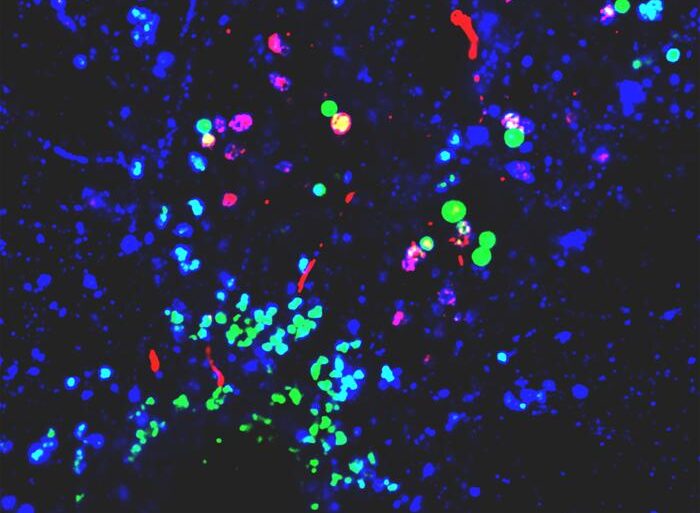The results of a study led by researchers at Duke University suggest that nanoplastics interact with a particular protein that is naturally found in the brain, creating changes linked to Parkinson’s disease and some types of dementia. The investigation, involving different laboratory models, including live mice, found that nanoplastics in the environment interact with α-synuclein in the brain, promoting α-synuclein fibril formation and aggregation. The fibrils and nanoplastic particles were internalized into neurons, converging at the lysosome.
“Our study suggests that the emergence of micro and nanoplastics in the environment might represent a new toxin challenge with respect to Parkinson’s disease risk and progression,” stated Andrew West, PhD, professor in the Department of Pharmacology and Cancer Biology at Duke University School of Medicine. “This is especially concerning given the predicted increase in concentrations of these contaminants in our water and food supplies.”
Reporting their findings in Science Advances, West and colleagues say that their findings create a foundation for a new area of investigation fueled by the impact of environmental factors on human biology. In their report, titled “Anionic nanoplastic contaminants promote Parkinson’s disease–associated α-synuclein aggregation,” the team concluded “These results highlight a potential link for further exploration between nanoplastic pollution and α-synuclein aggregation associated with Parkinson’s disease and related dementias.”
“Parkinson’s disease has been called the fastest growing neurological disorder in the world,” said principal investigator, said West. The disease, and related dementias, are pathologically defined by the accumulation of α-synuclein protein in vulnerable neurons in the brain, the authors noted. “Numerous lines of data suggest environmental factors might play a prominent role in Parkinson’s disease, but such factors have for the most part not been identified,” West added.
Increased plastic production and deposition of waste worldwide have resulted in microplastic contaminants in water and food supplies, the authors noted. “Microplastics, defined as particles smaller than five mm in diameter, can also include smaller nanoplastics (less than 1 μm). “Single-use polystyrene products, such as foam packing materials, cups, and cutlery, are largely responsible for widespread polystyrene waste that contributes to overall plastic pollution,” the team noted. “Negatively charged small plastic particles are found in marine environments as a presumed consequence of ultraviolet radiation exposures and plastic erosion.”
Interestingly, a recent study found that polystyrene plastic pollution, among a few other types of plastic, circulates in the blood of most adults tested. And in models, polystyrene nanoplastics have been reported to accumulate in the brain and penetrate into the parenchyma, the team further commented.
In their newly reported study West and colleagues at Duke’s Nicholas School of the Environment and the Department of Chemistry at Trinity College of Arts and Sciences found that nanoparticles of polystyrene—typically found in single use items such as disposable drinking cups and cutlery—bind to and attract the accumulation α-synuclein. West said the study’s most surprising findings are the tight bonds formed between the plastic and the protein within the lysosome, the area of the neuron where the accumulations were found to be congregating.
The team reported that this plastic-protein accumulation happened across three different models—in test tubes, cultured neurons, and mouse models of Parkinson’s disease. “Here, we find that anionic polystyrene nanoplastics bind to α-synuclein with low to subnanomolar affinity, which rapidly promotes α-synuclein fibril formation and fibril-seeded pathology in cultured neurons, as well as in dopaminergic neurons in the intact wild-type mouse brain,” they wrote. In mice, the nanoplastics combined with α-synuclein fibrils to exacerbate the spread of α-synuclein pathology across interconnected vulnerable brain regions, “… including the strong induction of α-synuclein inclusions in dopaminergic neurons in the substantia nigra.”
West said that questions remain about how such interactions might be happening within humans and whether the type of plastic might play a role. “While microplastic and nanoplastic contaminants are being closely evaluated for their potential impact in cancer and autoimmune diseases, the striking nature of the interactions we could observe in our models suggest a need for evaluating increasing nanoplastic contaminants on Parkinson’s disease and dementia risk and progression,” West said.
“The technology needed to monitor nanoplastics is still at the earliest possible stages and not ready yet to answer all the questions we have. But hopefully efforts in this area will increase rapidly, as we see what these particles can do in our models. If we know what to look out for, we can take the necessary steps to protect ourselves, without compromising all the benefits we reap every day from plastics.” In their paper the authors concluded, “These results highlight an emergent potential toxin in anionic nanoplastics that might be explored further to better understand a possible role in PD risk and progression.”
West said that questions remain about how such interactions might be happening within humans and whether the type of plastic might play a role. “While microplastic and nanoplastic contaminants are being closely evaluated for their potential impact in cancer and autoimmune diseases, the striking nature of the interactions we could observe in our models suggest a need for evaluating increasing nanoplastic contaminants on Parkinson’s disease and dementia risk and progression,” West said.
“The technology needed to monitor nanoplastics is still at the earliest possible stages and not ready yet to answer all the questions we have. But hopefully efforts in this area will increase rapidly, as we see what these particles can do in our models. If we know what to look out for, we can take the necessary steps to protect ourselves, without compromising all the benefits we reap every day from plastics.” In their paper the authors concluded, “These results highlight an emergent potential toxin in anionic nanoplastics that might be explored further to better understand a possible role in PD risk and progression.”




